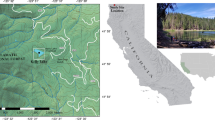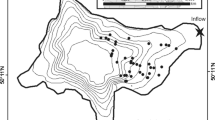Abstract
A new index, diatom model affinity (DMA) was erected as a reference-based community metric, derived from generic and species composition. DMA provides an assessment of water quality by the calculation of percent similarity to a model community, which can be viewed as a reference standard. High similarity to the model indicates communities that are minimally disturbed, while lower similarity suggests water quality problems. The index is similar to that developed for macroinvertebrate communities by Novak & Bode (1992, Journal of the North American Benthological Society 11: 80-85). The index correlated well with environmental factors operating on hierarchical scales. Compared to other commonly used diatom indices, DMA-based community assessments demonstrated high correspondence to patterns derived from multivariate statistics.
Similar content being viewed by others
References
Allen, A. P., T. R. Whittier, P. R. Kaufmann, D. P. Larsen, R. J. O'Connor, R. M. Hughes, R. S. Stemberger, S. S. Dixit, R. O. Brinkhurst, A. T. Herlihy & S. G. Paulsen, 1999a. Concordance of taxonomic richness patterns across multiple assemblages in lakes of the northeastern United States. Canadian Journal of Fisheries and Aquatic Sciences 56: 739-747.
Allen, A. P., T. R. Whittier, D. P. Larsen, P. R. Kaufmann, R. J. O'Connor, R. M. Hughes, R. S. Stemberger, S. S. Dixit, R. O. Brinkhurst, A. T. Herlihy & S. G. Paulsen, 1999b. Concordance of taxonomic composition patterns across multiple lake assemblages: effects of scale, body size, and land use. Canadian Journal of Fisheries and Aquatic Sciences 56: 2029-2040.
Bahls, L. L., 1993. Periphyton Bioassessment Methods for Montana Streams. Water Quality Bureau, Department of Health and Environmental Sciences, Helena, Montana, USA.
Barton, D. R., 1996. The use of Percent Model Affinity to assess the effects of agriculture on benthic invertebrate communities in headwater streams of southern Ontario, Canada. Freshwater Biology 36: 397-410.
Borchard, D., P. Legendre & P. Drapeau, 1992. Partialling out the spatial component of ecological variation. Ecology 73: 1045-1055.
Fishman, M. J., J. W. Raese, C. N. Gerlitz & R. A. Husband, 1994. U.S. Geological Survey Approved Inorganic and Organic Methods for the Analysis of water and fluvial sediment, 1954-94: U.S. Geological Survey Open-File Report 94-351, 1-55.
Kelly, M. G. & B. A. Whitton, 1995. The Trophic Diatom Index: a new index for monitoring eutrophication in rivers. Journal of Applied Phycology 7: 433-444.
Krammer, K., 2003. Diatoms of Europe: Cymbopleura, Delicata, Navicymbula, Gomphocymbellopsis, Afrocymbella. A.R.G. Ganter Verlag K.G., Ruggell, 530 pp.
Krammer, K. & H. Lange-Bertalot, 1986-1991. Bacillariophyceae, Teil 1-4. Gustav Fischer Verlag, Stuttgart.
Lange-Bertalot, H., 2001. Diatoms of Europe: Navicula sensu stricto, 10 Genera Separated from Navicula sensu lato, Frustulia. A.R.G. Ganter Verlag K.G., Ruggell, 526 pp.
Lawrence, G. B., T. A. Lincoln, D. Horan-Ross, M. O. Olson & L. W. Waldron, 1995. Methods of the U.S. Geological Survey, New York District Water Analysis Laboratory: U.S. Geological Survey Open-File Report 95-416, 78 pp.
Legendre, P. & L. Legendre, 1998. Numerical Ecology. Second English Edition, Elsevier Science B.V., Amsterdam, The Netherlands, 853 pp.
Lowe, R. L., 1974. Environmental Requirements and Pollution tolerance of Freshwater Diatoms. Cincinnati, Ohio, National Environmental Research Center, Office of Research and Development, U.S. Environmental Protection Agency: 670/4-74-005.
Magalhaes, M. F., D. C. Batalha & M. J. Collares-Pereira, 2002. Gradients in stream fish assemblages across a Mediterranean landscape: contributions of environmental factors and spatial structure. Freshwater Biology 47: 1015-1031.
McGarigal, K. & B. J. Marks, 1995. FRAGSTATS: A Spatial Pattern Analysis Program for Quantifying Landscape Structure. U.S. Department of Agriculture, Forest Service, Pacific Northwest Research Station, Gen. Tech. Rep. PNWGTR-351, Portland, OR, USA 122 pp.
Moss, D., M. T. Furse, J. F. Wright, & P. D. Armitage, 1987. The prediction of the macroinvertebrate fauna of unpolluted running-water sites in Great Britain using environmental data. Freshwater Biology 17: 41-52.
Naveh, Z., 2000. What is holistic landscape ecology? A conceptual introduction. Landscape and Urban Planning 50: 7-26.
Nitecki, M. W. & A. Hoffman, 1987. Neutral Models in Biology. Oxford University Press, New York.
Novak, M. A. & R. W. Bode, 1992. Percent model affinity: a new measure of macroinvertebrate community composition. Journal of the North American Benthological Society 11: 80-85.
Passy, S. I., Y. Pan & R. L. Lowe, 1999. Ecology of the major periphytic diatom communities from the Mesta River, Bulgaria. International Review of Hydrobiology 84: 129-174.
Prygiel, J., P. & 27 co-authors, 2002. Determination of the biological diatom index (IBD NF T 90-354): results of an intercomparison exercise. Journal of Applied Phycology 14: 27-39.
Richards, C., L. B. Johnson & G. E. Host, 1996. Landscapescale influences on stream habitats and biota. Canadian Journal of Fisheries and Aquatic Sciences 53(Suppl. 1): 295-311.
Round, F. E., R. M. Crawford & D. G. Mann, 1990. Diatoms: Biology and Morphology of the Genera. Cambridge University Press, Cambridge, 747 pp.
Slá;deček, V., 1986. Diatoms as indicators of organic pollution. Acta Hydrochimica et Hydrobiologica 14: 555-566.
Stevenson, R. J. & L. L. Bsahls, 1999. Periphyton protocols}. In Barbour, M. T., J. Gerritsen, B. D. Snyder & J. B. Stribling (eds), Rapid Bioassessment Protocols for Use in Streams and Wadeable Rivers: Periphyton, Benthic Macroinvertebrates and Fish, Second Edition. EPA 841-B-99-002. U.S. Environmental Protection Agency, Office of Water, Washington, DC: USA 6-1-6-23.
ter Braak, C. J. F. & P. Smilauer, 1998. CANOCO Reference Manual and User's Guide to Canoco for Windows: Software for Canonical Community Ordination (version 4). Microcomputer Power, Ithaca, New York, 352 pp.
van Dam, H., A. Mertens & J. Sinkeldam, 1994. A coded checklist and ecological indicator values of freshwater diatoms from the Netherlands. Netherlands Journal of Aquatic Ecology 28: 117-133.
Watanabe, T., K. Asai & A. Houki, 1986 Numerical water quality monitoring of organic pollution using diatom assemblages. In Round, F. (ed.), Proceedings of the 9th Diatom Symposium. Koenigstein, O. Koeltz Publ.: 123-141.
Whittaker, R. H. & C. W. Fairbanks, 1958. A study of plankton copepod communities in the Columbia basin, southeastern Washington. Ecology 39: 46-65.
Wu, J. T., 1999. A generic index of diatom assemblages as bioindicator of pollution in the Keelung River of Taiwan. Hydrobiologia 397: 79-87.
Author information
Authors and Affiliations
Rights and permissions
About this article
Cite this article
Passy, S.I., Bode, R.W. Diatom Model Affinity (DMA), a New Index for Water Quality Assessment. Hydrobiologia 524, 241–252 (2004). https://doi.org/10.1023/B:HYDR.0000036143.60578.e0
Issue Date:
DOI: https://doi.org/10.1023/B:HYDR.0000036143.60578.e0




